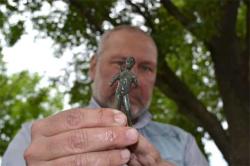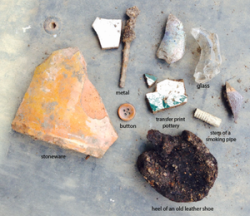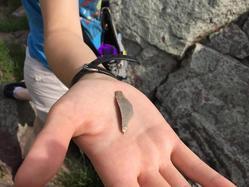INSTITUT SUPERIEUR D'ANTHROPOLOGIE
INSTITUTE OF ANTHROPOLOGY
ONLINE COURSES / COURS A DISTANCE
FALL TERM : OCTOBER 2015
REGISTER NOW
BULGARIE –  Perperikon - A Late Antiquity Roman temple and a bronze statuette of Ancient Greek god Apollo holding a bow have been discovered by the team of Bulgarian archaeologist Prof. Nikolay Ovcharov on the second day of the 2015 summer excavations on the prehistoric, ancient, and medieval rock city and fortress of Perperikon, also known as Perperik. The bronze statuette of Apollo is dated to the 3rd century AD, and is a very sophisticated work, saysOvcharov, as cited by the Bulgarian state news agency BTA. No statues or statuettes of Apollo had been found in Perperikon before. It was found just meters away from a newly discovered Ancient Roman temple, also from the 3rdcentury AD, the second Roman temple to be found in the rock city of Perperikon located near the city of Kardzhali in the Rhodope Mountains. “This is the second Roman temple found in Perperikon. The first one was discovered 5-6 years ago, and in it we found a clay altar and an icon of the Thracian Horseman (the supreme deity of the Ancient Thracians, also known as Heros).This proves once again that Perperikon is not all about the Middle Ages, as some claim. We can now speak for sure about a pagan period of Perperikon from the Roman Age,” Ovcharov comments. “The Apollo statuette is a cult figurine, part of the interior of the temple, one more confirmation about the pagan period of Perperikon during the Roman Age,” adds the archaeologist, who has beenexcavating the rock city of Perperikon since 2000.
Perperikon - A Late Antiquity Roman temple and a bronze statuette of Ancient Greek god Apollo holding a bow have been discovered by the team of Bulgarian archaeologist Prof. Nikolay Ovcharov on the second day of the 2015 summer excavations on the prehistoric, ancient, and medieval rock city and fortress of Perperikon, also known as Perperik. The bronze statuette of Apollo is dated to the 3rd century AD, and is a very sophisticated work, saysOvcharov, as cited by the Bulgarian state news agency BTA. No statues or statuettes of Apollo had been found in Perperikon before. It was found just meters away from a newly discovered Ancient Roman temple, also from the 3rdcentury AD, the second Roman temple to be found in the rock city of Perperikon located near the city of Kardzhali in the Rhodope Mountains. “This is the second Roman temple found in Perperikon. The first one was discovered 5-6 years ago, and in it we found a clay altar and an icon of the Thracian Horseman (the supreme deity of the Ancient Thracians, also known as Heros).This proves once again that Perperikon is not all about the Middle Ages, as some claim. We can now speak for sure about a pagan period of Perperikon from the Roman Age,” Ovcharov comments. “The Apollo statuette is a cult figurine, part of the interior of the temple, one more confirmation about the pagan period of Perperikon during the Roman Age,” adds the archaeologist, who has beenexcavating the rock city of Perperikon since 2000.
http://archaeologyinbulgaria.com/2015/06/10/bulgarian-archaeologists-find-roman-temple-apollo-statuette-in-excavations-of-ancient-rock-city-perperikon/
USA –  Niles - The Fort St. Joseph Archaeological Project, a partnership between Western Michigan University and the city of Niles, is gearing up for its ninth annual open house to showcase its latest artifacts from what by the 18th century had become one of the most important frontier outposts in the Great Lakes region. This year's theme for the event, "Seeking Shelter from the Storm: Architecture in 18th Century New France," will emphasize the structural properties of Fort St. Joseph. Anthropologists speculate the fort community was made up of five buildings. Built in the late 1600s, Fort St. Joseph originally functioned as a mission for French Jesuit priests, but turned into a military base and a trading post. In less than a century, France, Great Britain and Spain conquered the structure before it became American territory. Since its rediscovery in 1998, the WMU field school participants have excavated the site nearly every year. They've turned up such artifacts as gun parts, ceramics, copper kettles, animal bones, beads, pipe stems and bowls, mouth harps and arrowheads. Because of the site's proximity to the St. Joseph River, water must be pumped out of the soil at all times to prevent the site from flooding. Despite the difficulties, Tim Bober, an anthropology professor at WMU, said the fort has yielded the most artifacts he has ever seen from one location.
Niles - The Fort St. Joseph Archaeological Project, a partnership between Western Michigan University and the city of Niles, is gearing up for its ninth annual open house to showcase its latest artifacts from what by the 18th century had become one of the most important frontier outposts in the Great Lakes region. This year's theme for the event, "Seeking Shelter from the Storm: Architecture in 18th Century New France," will emphasize the structural properties of Fort St. Joseph. Anthropologists speculate the fort community was made up of five buildings. Built in the late 1600s, Fort St. Joseph originally functioned as a mission for French Jesuit priests, but turned into a military base and a trading post. In less than a century, France, Great Britain and Spain conquered the structure before it became American territory. Since its rediscovery in 1998, the WMU field school participants have excavated the site nearly every year. They've turned up such artifacts as gun parts, ceramics, copper kettles, animal bones, beads, pipe stems and bowls, mouth harps and arrowheads. Because of the site's proximity to the St. Joseph River, water must be pumped out of the soil at all times to prevent the site from flooding. Despite the difficulties, Tim Bober, an anthropology professor at WMU, said the fort has yielded the most artifacts he has ever seen from one location.
http://www.southbendtribune.com/news/local/archeology-project-continues-to-uncover-niles-fort-history/article_fe9bcf42-11ab-11e5-8738-7b5cac1c702f.html
IRLANDE – Strandhill- A team of international archaeologists is carrying out a cutting edge 'geoarchaeological' survey to unlock the secrets of prehistoric sites at Strandhill's famous Shelly Valley.Middens - mounds of shells, bone and charcoal - are ancient refuse heaps built from the remains of discarded food waste. Shelly Valley - named after the Middens - is home to a large number of these sites which are believed to date to the Stone Age and are visible at the base of the dune. Dr. Bonsall and his IT Sligo students are using the latest geophysical and high resolution mapping methods to 'see beneath the sands' to map the extent of the Middens. Katharine Napora will be using a combination of analytical geoarchaeological techniques on the Middens to unlock their secrets. "We're hoping to find out how old the different Middens are, if they were constructed at the same time, how long they were used for and what types of food our ancestors were eating," says Katharine.
http://www.independent.ie/regionals/sligochampion/news/strandhills-dunes-are-home-to-prehistoric-dumps-31286808.html
USA –  Dubuque - Thus far, Dan McCullough and other employees of Tallgrass Historians L.C. have discovered Dubuque's working-class Irish and German immigrants from the mid-19th century did much the same as many residents today, including having an occasional drink or smoke. The Iowa City-based archaeology firm has uncovered growlers from Dubuque Brewing & Malting Co., their ceramic tops and its insignia still perfectly legible, ceramic smoking pipes and the foundation of an old tavern suspected to date back to the 1850s or 1860s. Thus far, firm employees have found ceramics, dishes, stoneware, buttons, smoking pipes, bottles and miscellaneous metals. Leah Rogers, principal investigator and part-owner of Tallgrass Historians, speculated the tavern dates to the mid-19th century, based on its construction and orientation and based on bird's-eye illustrations and fire-insurance maps of the area around that time. "It's aligned with the original route of Garfield Avenue, which is not the same as it is today," and the tavern was likely torn down in the 1960s, Rogers said. Workers also uncovered a unusual spherical brick cistern. Most cisterns tend to be bell-shaped or cylindrical, she said. From Dubuquers' discarded and excreted remains, Rogers hopes to gain a clearer picture of the health, well-being, social habits and income levels of the area dating back nearly 150 years.
Dubuque - Thus far, Dan McCullough and other employees of Tallgrass Historians L.C. have discovered Dubuque's working-class Irish and German immigrants from the mid-19th century did much the same as many residents today, including having an occasional drink or smoke. The Iowa City-based archaeology firm has uncovered growlers from Dubuque Brewing & Malting Co., their ceramic tops and its insignia still perfectly legible, ceramic smoking pipes and the foundation of an old tavern suspected to date back to the 1850s or 1860s. Thus far, firm employees have found ceramics, dishes, stoneware, buttons, smoking pipes, bottles and miscellaneous metals. Leah Rogers, principal investigator and part-owner of Tallgrass Historians, speculated the tavern dates to the mid-19th century, based on its construction and orientation and based on bird's-eye illustrations and fire-insurance maps of the area around that time. "It's aligned with the original route of Garfield Avenue, which is not the same as it is today," and the tavern was likely torn down in the 1960s, Rogers said. Workers also uncovered a unusual spherical brick cistern. Most cisterns tend to be bell-shaped or cylindrical, she said. From Dubuquers' discarded and excreted remains, Rogers hopes to gain a clearer picture of the health, well-being, social habits and income levels of the area dating back nearly 150 years.
http://www.thonline.com/news/tri-state/article_c3b90e4d-b569-54ec-b00c-1653aa835952.html
INDE – Cuttack - A tunnel-like structure discovered during a road digging work at Kathagada Sahi here on May 20 is probably part of an underground sewerage and drainage system constructed during the British period.
http://timesofindia.indiatimes.com/City/Bhubaneswar/Cuttack-structure-not-a-tunnel-Cuttack-Municipal-Corporation/articleshow/47653721.cms
USA –  Buena Vista / Cherokee counties - A recent two-week archaeology field school for young diggers hit pay dirt -- uncovering four previously unknown prehistoric sites in Buena Vista and Cherokee counties within a matter of days. Water is the key to locating prehistoric sites in the region, she confides. "Just like people today, the native people here tended to locate near water. There are not a lot of water sources in northwest Iowa, so it's almost a guarantee that there is something to find along every river or large creek." The artifacts discovered were stone chippings, called flakes, which indicate that the sites were stone tool production areas, possibly associated with organized hunting groups or perhaps a village area nearby. So far, no diagnostic evidence has been found -- complete arrow or spear points or decorated pottery shards with distinct styles that could be used to date the sites or associate them with a specific group of prehistoric people. They could be 1,000 years old, or they could be 13,000 years old, Stroh says. Two sites were found on ridges directly across from each other in Cherokee County. The other two were discovered in northwestern Buena Vista County, both at the top edge of the same bluff, about 100 meters apart. The Little Sioux River Watershed is dense with some of the most important archaeological sites in Iowa, however, only a small portion of the watershed has been professionally surveyed," she said.
Buena Vista / Cherokee counties - A recent two-week archaeology field school for young diggers hit pay dirt -- uncovering four previously unknown prehistoric sites in Buena Vista and Cherokee counties within a matter of days. Water is the key to locating prehistoric sites in the region, she confides. "Just like people today, the native people here tended to locate near water. There are not a lot of water sources in northwest Iowa, so it's almost a guarantee that there is something to find along every river or large creek." The artifacts discovered were stone chippings, called flakes, which indicate that the sites were stone tool production areas, possibly associated with organized hunting groups or perhaps a village area nearby. So far, no diagnostic evidence has been found -- complete arrow or spear points or decorated pottery shards with distinct styles that could be used to date the sites or associate them with a specific group of prehistoric people. They could be 1,000 years old, or they could be 13,000 years old, Stroh says. Two sites were found on ridges directly across from each other in Cherokee County. The other two were discovered in northwestern Buena Vista County, both at the top edge of the same bluff, about 100 meters apart. The Little Sioux River Watershed is dense with some of the most important archaeological sites in Iowa, however, only a small portion of the watershed has been professionally surveyed," she said.
http://www.spencerdailyreporter.com/story/2204420.html
USA – Kingston - Plans for new ballfields at the town’s Opachinski Sports Complex have been called off after due to the discovery of what are believed to be Native American human remains. A projectile point found on the surface of the burial feature dates back 9,000 to 11,000 years. The discovery of bone and other features associated with human burial halted site work on June 5 at the archaeological dig site off Pottle Street.
http://www.patriotledger.com/article/20150612/NEWS/150618156/12662/NEWS
BULGARIE –  Chernomorets - Archaeological excavations at the Roman stronghold in the eastern part of the town of Chernomorets continue. Dr Ivan Hristov with the National Museum of History announced the information for Radio FOCUS/b>. The archaeologists have already explored four towers and are now entering the inner part of the stronghold. They have found more than 50 utensil and containers at site 8, which are characteristic for the end of the VI and the beginning of the VII centuries. There are also amphorae from North Africa, currently Tunisia.
Chernomorets - Archaeological excavations at the Roman stronghold in the eastern part of the town of Chernomorets continue. Dr Ivan Hristov with the National Museum of History announced the information for Radio FOCUS/b>. The archaeologists have already explored four towers and are now entering the inner part of the stronghold. They have found more than 50 utensil and containers at site 8, which are characteristic for the end of the VI and the beginning of the VII centuries. There are also amphorae from North Africa, currently Tunisia.
http://www.focus-fen.net/news/2015/06/14/375337/bulgarian-archaeologists-find-north-african-amphorae-in-chernomorets.html?